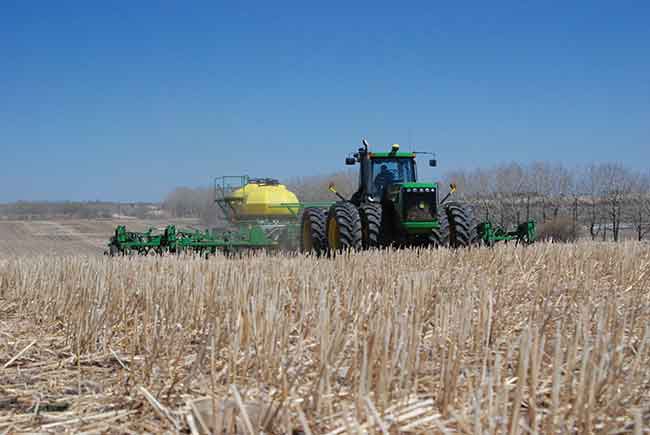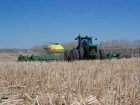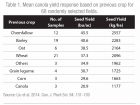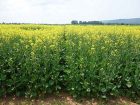
Features
Agronomy
Canola
Grower insights into top canola production
Research abounds on best management practices for top canola yields, but where the rubber hits the road is out in the field. A survey of 68 randomly selected canola farm fields across the Prairies identified the top practices farmers use to target high yield.
November 8, 2016 By Bruce Barker
 Seeding early and shallow are key management practices for high yield. Research abounds on best management practices for top canola yields
Seeding early and shallow are key management practices for high yield. Research abounds on best management practices for top canola yields“Many canola producers have accumulated extensive knowledge and experience over the years in producing best canola crops under their specific growing environments and conditions. This knowledge and experience may serve as a first-hand source of information in the development of sound guidelines for less experienced canola producers,” says Yantai Gan, a research scientist with Agriculture and Agri-Food Canada (AAFC) in Swift Current, Sask. Gan led the team, along with a master’s student from the University of Manitoba.
The survey was conducted in spring 2011 and data collation was completed by October 2012. The research team made multiple field trips to collect data on soil properties and growing conditions, as well as measurements on seedling emergence, seeding depth, row spacing and yield data.
Gan summarized the key management practices for high yield in canola were seeding shallow and directly into chemfallow (or crops with inherently short stubble) at earlier dates with narrow row spacing, and avoiding seeding into canola stubble.
There was a large variation in terms of data uniformity across the individual farm fields; some of the cropping practices were adopted by the majority of the canola producers, whereas other practices were used only by a few individual farmers.
Based on the survey data, canola produced in Alberta (44.6 bushels per acre, or bu/ac) averaged 23 per cent greater than canola produced in southern Saskatchewan (36.3 bu/ac), 10 per cent greater than canola produced in northern Saskatchewan (40.5 bu/ac), and 59 per cent greater than canola produced in Manitoba (28 bu/ac).
Avoid canola on canola
Canola performed best on chemfallow and worst on canola stubble. About 40 per cent of the producers grew their canola on cereal stubble, 17 per cent on chemfallow, and the rest on other crop stubbles. Three of the fields were canola on canola.
Canola yield responses were as follows: chemfallow > barley = oat = wheat > others = grain legumes = corn > canola. Canola produced on chemfallow averaged seed yield of 45.5 bu/ac, which was 17 per cent greater than canola that was grown on barley, oat or wheat stubble. Canola grown on canola stubble produced 54 per cent of the seed yield compared to canola grown on cereal (barley, oat, wheat) stubble, or 46 per cent of the seed yield compared to canola grown on chemfallow.
Gan says these results suggest good soil moisture combined with soil available nutrients is a key factor in high yield, and that chemfallow was able to provide the highest yields because of better moisture and improved soil fertility.
Pre-seeding herbicide application significantly affected canola yield, with the use of glyphosate plus MCPA significantly increasing canola yield by 35 per cent compared with canola receiving none or glyphosate only, Gan says. Fall application of glyphosate and pre-seeding glyphosate plus MCPA yielded similarly. It should be noted, however, that a glyphosate-MCPA tank mix is not registered for pre-seed application prior to canola due to the risk of germination damage.
The survey found growers should target plant stand populations using thousand kernel weight calculations and germination rate to develop seeding rates. Gan says growers also should take note of the typical survival rate of the seedlings on their fields, and adjust their seeding rate accordingly to achieve the target plant stand.
About 10 per cent of the producers used a straight combine when harvesting canola crops. Straight combining resulted in a significantly higher yield of about 8.9 bu/ac, or 24 per cent more than swathing.
The negative factors
Deeper seeding, wider row spacing, increased stubble height of previous crops, and delayed seeding after April 25 all reduced canola seed yield significantly. Gan says seeding depth research of canola on the Prairies has consistently found reduction in yield when canola is sown deep. Similarly, seeding date research on canola has found later seeding decreases yield. This was confirmed by farmers who participated in this survey.
Response of seeding into varying stubble heights can be more variable, depending on soil-climatic conditions. Research at AAFC Swift Current found tall stubble often helps conserve more soil moisture, minimize wind damage to canola seedlings in the early spring, and thus increase seed yield and water use efficiency. Conversely, in wetter, cooler areas, seeding canola into standing tall stubble may result in lower yields because soil temperatures may be lower, which delays seedling emergence.
Gan says the survey results help validate small plot research results but on a large-scale basis. “It would have been preferable to sample a greater number of farms, but it is a challenge to obtain such detailed on-farm information on a larger scale. Nonetheless, the knowledge and findings generated from this on-farm research may serve as the first-hand source of information in the development of sound guidelines for less experienced canola producers in Western Canada.”


